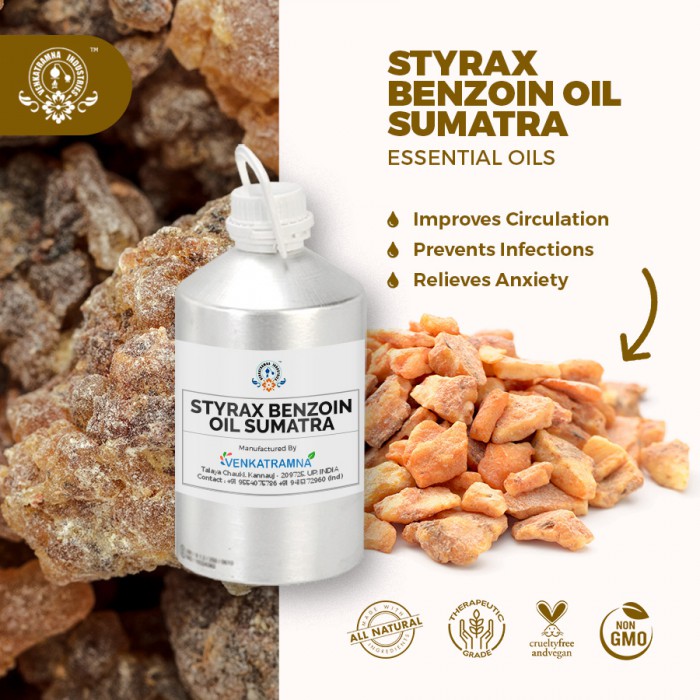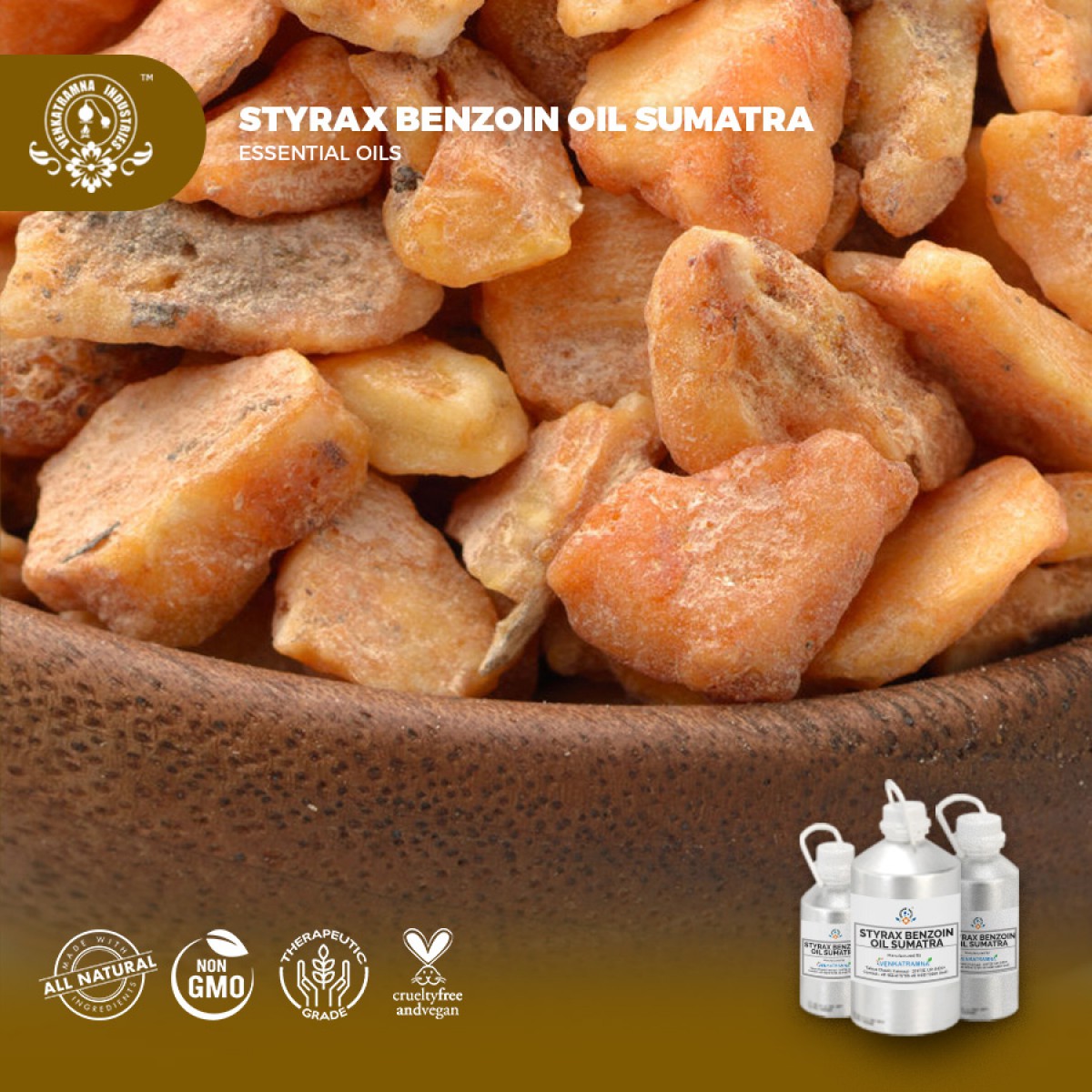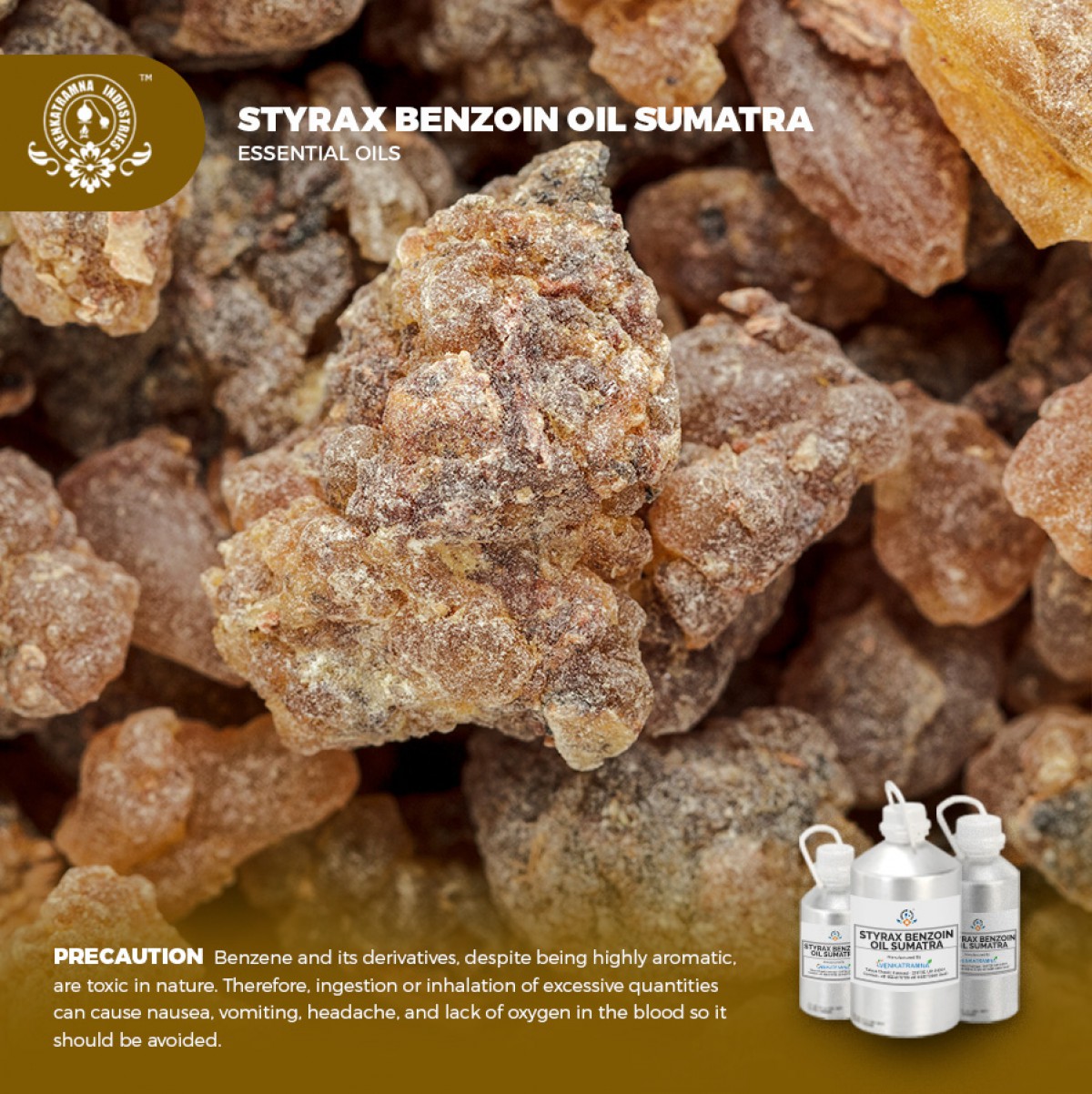Botanical Name: Styrax benzoin Common name: Styrax Benzoin Plant Read More
|
Botanical Name: |
Styrax benzoin |
|
Common name: |
Styrax
Benzoin |
|
Plant
family: |
Streacaceae |
|
Genus: |
Styrax |
|
Appearance/Color: |
A thick brown,
viscous liquid. |
|
Odor: |
Has a sweet, warm and
vanilla-like aroma that is used as a base note with a medium aroma. |
|
Blends With: |
Cardamom,
Frankincense, Myrrh, Myrtle, Neroli, Orange, Petitgrain and Sandalwood. |
|
Origin: |
Indonesia |
|
Source: |
Resin |
|
Method
of Extraction: |
Solvent
Extraction |
The Styrax Benzoin tree is
similar to a rubber tree, its height can reach 30 meters, this plant is
perennials which is one of the sturdiest plants. The tree can thrive in
mountainous areas and cold temperatures with high rainfall. Styrax tree can
also grow in lowland areas with have hot temperatures but not produce good
quality styrax sap.
Its take one year to process of
tapping and harvesting frankincense. A cut made in styrax benzoin tree trunk by
little so that the white styrax sap will appear from the skin. After 4-6 months
of the styrax sap hardens on the tree trunks then the incense sap can be
harvested. The Styrax Sumatrana sap that has been harvested is not clean. The
skin of incense and other impurities must separate. Usually it is dry for 3-6
months. After incense sap already dry, the incense sap ready to be export.
The kemenyan tree founded arround 200o years ago. In Bible have found some articles about that. Some people give kemenyan when Yesus born at Betlehem. Indian have using kemenyan for thousand year ago. They use it for their worship.
DISCLAIMER
The complete range of conditions
or methods of use are beyond our control therefore we do not assume any
responsibility and expressly disclaim any liability for any use of this
product. Information contained herein is believed to be true and accurate however,
all statements or suggestions are made without warranty, expressed or implied,
regarding accuracy of the information, the hazards connected with the use of
the material or the results to be obtained from the use thereof. Compliance
with all applicable federal, state, and local laws and local regulations
remains the responsibility of the user.
The FDA has not evaluated the
statements on this website. No claims are made by Venkatramna Industries as to
the medicinal value of any products from vriaroma.com or by us. The information
presented here is for educating our customers about the traditional uses of
essential oils and is not intended to diagnose, treat, cure, or prevent any
disease. You are responsible for understanding the safe application of these products.
If you have any questions, please call or email us for further information.
As per NAHA guidelines, New Directions Aromatics
(NDA) does not recommend the ingestion of essential oils. It is imperative to
consult a medical practitioner before using Essential Oils for therapeutic
purposes. Pregnant and nursing women and those taking prescription drugs are
especially advised not to use this product without the medical advice of a
physician. The oil should always be stored in an area that is inaccessible to
children, especially those under the age of 7.
Benzoin is a balsam obtained by
wounding the stem cambium of several Styrax species. It finds
extensive use worldwide as incense and in the flavour, fragrance and pharmaceutical
industries. In volume terms, Benzoin (the product of S. benzoin and S.
tonkinensis) is the most important type of benzoin and it is used for
incense in e.g. the Middle East, North Africa, parts of Asia and the Indian
sub-continent. Most commonly, small or crushed pieces of the raw benzoin in
semi-processed block form are simply placed on an open fire, either in the
house or in the place of worship. Sometimes it is mixed with other natural
fragrance resins such as frankincense (Boswellia spp.), myrrh
(Copaifera spp.) and storax (Liquidambar orientalis Mill.). Extracts
of Sumatra benzoin are used to produce fragrances for joss sticks. In Java,
benzoin is applied for ritual ceremonies related to death or spirits. Siam and
Sumatra benzoin are both used for flavour and fragrance purposes but usually
satisfy different parts of the markets. Siam benzoin has a rounder, more
vanilla-like odour than Sumatra benzoin, which is harsher to the nose. The
better grades of benzoin are extracted for the manufacture of fragrant
products. These include personal health care products (e.g. toilet soaps,
shampoos, body lotions, creams) and household and other products (e.g. liquid
soaps, air fresheners, washing detergents). Although there is occasional
overlap in end-use, the pleasant, rounder fragrance of the more expensive Siam
benzoin is generally found in fine fragrances (perfumes and colognes) and the
more expensive soaps. Although benzoin contributes its own fragrance to the
final, formulated product, one of its important functions is to serve as a
fixative for the other fragrance materials, increasing the tenacity and
preventing loss of the middle and top notes of the more volatile components.
Benzoin is well-known in both
allopathic and traditional medicine. Several national pharmacopoeias specify
either Siam or Sumatra types, while others include both. In the form of a
tincture, benzoin is inhaled with steam for the relief of catarrh, laryngitis,
bronchitis and upper respiratory tract disorders. It is also used for the
prevention and treatment of cold sores, for the treatment of warts and to
freshen and soothe dry skin and ameliorate skin allergies. Benzoin is employed
similarly in the form of over-the-counter herbal medicines and in aromatherapy
in western societies. Taken internally, benzoin acts as a carminative,
expectorant and diuretic.
In Vietnam, S.
tonkinensis is planted for pulp production. In the past, matches were made
from the wood. In the highlands of Laos the wood is an appreciated source of
building material because of its resistance to insects.
Benzoin's principal role in foods
is as a flavouring agent. Sumatra benzoin is used particularly in the
manufacture of chocolate flavours for chocolate bars, ice-cream, milk products,
syrups and other products. Benzoin is popular in Scandinavia as a flavouring in
baked goods containing vanilla or cassia, where it also serves to
"fix" the other flavours and increase their spiciness. In Japan
benzoin is applied as a chewing gum base. In Central Java (Indonesia) an
important outlet for Sumatra benzoin is in flavouring tobacco by mixing it with
tobacco when making cigarettes. However, it finds wider application in the
production of "Manila" and other types of tobacco flavour. Benzoin is
also employed by the tobacco industry in China.
COMMON
USAGE
·
Improves circulation
·
Relieves anxiety
·
Prevents infections
·
Prevents sepsis
·
Improves digestion
·
Removes bed odor
·
Reduces skin wrinkles
·
Treats cough
·
Facilities urination
·
Soothes inflammation
·
Relieves symptoms of arthritis
Ingredients:
|
S.No |
Key Constituents |
Strength (%) |
|
1 |
Benzoin |
60-70 |
|
2 |
Ethanol |
30-40 |
|
3 |
Benzyl benzoate |
1-5 |
|
4 |
Benzyl Cinnamate |
0.1-1 |
|
5 |
Isoeugenol |
<1 |
|
6 |
Benzyl Alcohol |
<1 |
|
7 |
Benzyl Salicylate |
<1 |
|
8 |
Cinnamyl Alcohol |
<1 |
|
9 |
Cinnamal |
<1 |
|
10 |
Eugenol |
<1 |
|
11 |
Geraniol |
<1 |
Safety Summary
·
Hazards Skin sensitization (low risk).
·
Cautions (dermal) Hypersensitive,
diseased or damaged skin, children under 2 years of age.
·
Maximum adult daily oral dose 368mg.
·
Maximum dermal use level 2%
Organ Specific Effects
·
Adverse skin reaction: In a modified Draize procedure on
guinea pigs, benzoin ‘oil’ was skin sensitizing when used at 10% in the
challenge phase. Benzoic acid and cinnamic acid have produced some allergic
reactions. Benzyl benzoate and benzyl alcohol are listed in the EU as
allergens, but the risk of allergy from either is negligible. In patch tests of
477 dermatitis patients, 45 (9.2%) had a positive reaction to compound tincture
of benzoin. Of the 45, 14 had strong positive reactions, and 28 had
cross-reactions to similar allergens. Up to 80% of patients sentitive to Peru
balsam reacted positively to Siamese benzoin. Since both raw materials contain
coniferyl benzoate this may be responsible, but it is not known to be present
in benzoin resinoids.
·
Reproductive Toxicity: The reproductive
toxicity data for benzyl benzoate, benzyl alcohol, benzoic acid and cinnamic
acid do not suggest any restrictions in the use of benzoin resinoid in
pregnancy beyond those outlined above.
Systemic Effects
·
Acute
Toxicity: No information
found.
·
Antioxidant/pro-oxidant activity: No Data Available
·
Carcinogenic/anti carcinogenic potential: No Data Available
Toxicity
·
Acute fish toxicity: LC50 / 96 HOUR – No
data available
·
Toxicity to aquatic plants – No data
available
·
Toxicity to microorganisms – No data
available
·
Toxicity threshold – No data available
·
Persistence and degradability:
Biodegradation is expected
·
Bio-accumulative potential:
Bioaccumulation is unlikely
·
Mobility in soil: Unknown
Avoid exposure to marine environments and waterways





 PS-Benzoin1.pdf
PS-Benzoin1.pdf




